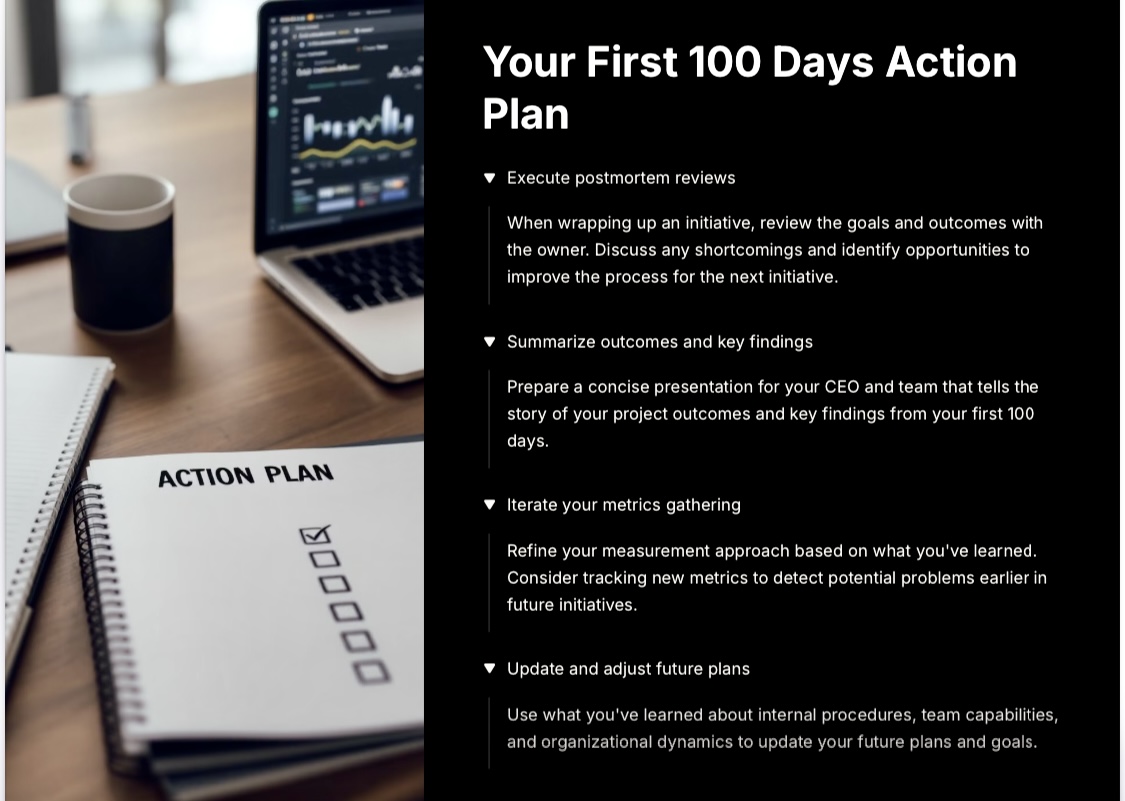First 100 Days for CRO - M. Allen Approach
Mar 11, 2025
Entering a new organization as a Head of Sales or a similar executive role is a pivotal moment that sets the tone for your tenure. Drawing from the insights provided by Matt Slonaker of M. Allen in the "First 100 Days Roadmap" and the "Growth Areas for a Financial Services CEO & M. Allen's Entry Diagnostic," my approach to entering a new organization is deliberate, strategic, and rooted in building a foundation for long-term success. Here’s a narrative outlining my method:

The First Impression: Preparation and Strategic Alignment (Days -10 to 15)
My journey begins before I even step into the role. In the preparation phase, I immerse myself in understanding the organization’s landscape. I start by building a strong relationship with the CEO, seeking clarity on their vision, key concerns, and the business priorities I’ll be expected to address. This alignment ensures my sales initiatives resonate with the broader corporate strategy. For instance, if the company is navigating post-pandemic market shifts or facing revenue stagnation—as highlighted in the diagnostic—I’ll study how these dynamics have impacted the business model and sales function.
Next, I identify key stakeholders across the enterprise—peers, team members, and even channel partners—and map out their influence and expectations. Understanding the organizational culture is equally critical; I listen to how the sales team and other departments perceive their roles and the company’s direction. This phase is about resisting the urge to act impulsively. As Slonaker advises, “Stop: Slow down.” I use this time to gather intelligence, avoiding quick changes that could disrupt without insight.
Gaining Perspective: Assessment and Connection (Days 0 to 30)
Once I’m in the role, the assessment phase is where I roll up my sleeves and dig into the current state. I conduct listening tours, engaging with everyone from the CEO to frontline sales reps and even customers, to uncover the real challenges and opportunities. I evaluate the sales function’s maturity—assessing performance metrics, organizational structure, technology stack, and budget allocation over the past 3-5 years. The diagnostic’s emphasis on gaps like customer experience (rated 5 for importance but 2 for capability) or marketing operations (a significant blind spot for over 80% of firms) guides my focus areas.
Building trust with the team is a priority here. I employ a structured exercise—introducing myself, stepping out while the team discusses key questions, and then returning for a joint dialogue—to foster open communication. This not only reveals team dynamics but also signals my commitment to collaboration. Connecting with stakeholders across the organization strengthens these relationships, mitigating transition risks and leveraging the brief “honeymoon” period to advance my agenda.
Crafting the Path Forward: Planning with Purpose (Days 15 to 45)
With a solid understanding in hand, I move into the planning phase, synthesizing insights into a strategic roadmap. I prioritize issues like improving customer experience—mapping the customer journey to turn it into a competitive edge—or addressing quota misalignment, where the diagnostic notes executives are often misled by attainment metrics. I identify quick wins—small, visible successes like streamlining lead management—to build momentum, knowing research suggests this can boost new leader effectiveness by nearly 20%.
Budget planning becomes a lens for cost reduction opportunities, while post-pandemic strategies address remote work or market re-entry challenges. Communication is key here—I share initial observations with the CEO and stakeholders, hold regular meetings with sales leadership to tackle obstacles, and host town halls to align the broader team with my vision. My messaging is concise, business-focused, and tied to strategic objectives, soliciting feedback to refine plans and secure buy-in.
Driving Results: Action with Agility (Days 30 to 80)
The act phase is where I operationalize my plans. I launch quick wins—perhaps optimizing account prioritization based on willingness-to-pay insights from the diagnostic—to address stakeholder pain points and demonstrate impact. I refine the team, recognizing top performers and addressing structural gaps, while selecting initiative owners with clear expectations and metrics. Engaging with existing projects, I ensure execution stays crisp and value-driven, establishing feedback loops to stay agile.
For example, if the diagnostic highlights a need for a robust pricing organization, I might pilot a cross-functional pricing team, leveraging marketing and sales insights to package solutions for a 15% sales uplift. This phase is about delivering visible results while adapting to emerging challenges.
Proving Impact: Measurement and Iteration (Days 45 to 100)
Finally, the measure phase allows me to showcase my influence. I track metrics—revenue growth, customer satisfaction scores, or lead conversion rates—and gather anecdotal feedback to assess the effect of my initiatives. Early wins, like those in customer experience or quota alignment, serve as evidence of progress. I conduct postmortem reviews with initiative owners, summarizing outcomes for the CEO and team, and use these insights to iterate metrics and adjust future plans.
This continuous refinement ensures I address the diagnostic’s warning signs—such as eroding competitive advantages or stagnant market share—by aligning with organizational dynamics and team capabilities. My approach is a cycle of preparation, assessment, action, and measurement, designed to transform the sales function into a growth engine while fostering a culture of accountability and innovation.
Guiding Principles
Throughout this process, I adhere to M. Allen’s ethos of “Growth in Action”—studying the art and science of sales, preparing diligently, and persevering through challenges. By leveraging proven methodologies, external expertise, and agile approaches, I aim to bridge the readiness gaps identified and position the organization for sustained revenue growth. This narrative reflects a thoughtful, data-driven entry strategy, tailored to the unique needs of the new organization while maximizing my impact in the critical first 100 days.
- Matt Slonaker
Founder of M. Allen LLC
